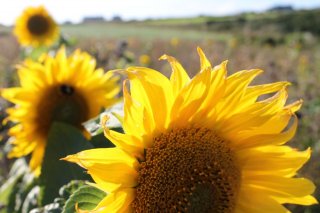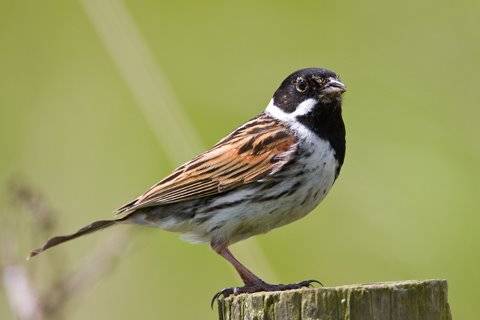 Colourful mustard and phacelia within the wild bird seed mix plot
Colourful mustard and phacelia within the wild bird seed mix plot
If you've taken a walk around Lizard Point recently, you may have spied a blaze of blue and yellow adorning one of the arable fields near Housel Bay. This is a one hectare plot of wild bird seed mix, which has been planted as part of a Higher Level Stewardship Scheme covering Tregullas, a National Trust farm. The plot is designed to be a living bird table, growing a mix of plants with small seeds that farmland birds love to eat. The plot will be in place for two years, before being sown again somewhere else on the farm, thereby keeping a constant supply of seed available to wild birds.
 Being the first year of our new HLS scheme, and our first experience of wild bird seed plots, we didn't know quite what to expect. As you can see the results have been extremely colourful! The mix includes millet, canary seed, buckwheat and sunflower. However, it was the yellow flowered mustard and purple flowered phacelia that came to the fore early in the summer. Phacelia is a relative of borage, and it is a great source of nectar for insects, which then become food for birds. Even seed eating birds like cirl buntings feed their chicks insects, to give them a protein rich start in life, so more insects buzzing about are good for wildlife all round.
Being the first year of our new HLS scheme, and our first experience of wild bird seed plots, we didn't know quite what to expect. As you can see the results have been extremely colourful! The mix includes millet, canary seed, buckwheat and sunflower. However, it was the yellow flowered mustard and purple flowered phacelia that came to the fore early in the summer. Phacelia is a relative of borage, and it is a great source of nectar for insects, which then become food for birds. Even seed eating birds like cirl buntings feed their chicks insects, to give them a protein rich start in life, so more insects buzzing about are good for wildlife all round.
As the season has progressed, the sunflowers have taken centre stage in spectacular fashion, proving popular with the local bumble bees. We look forward to seeing which birds make use of this area over winter. Reed buntings would be nice, but much rarer cirl or corn buntings would be even more welcome! Both of these now scarce farmland species have been sighted at Tregullas in winter before, so with plenty of food on offer we hope to tempt them back.
We look forward to seeing which birds make use of this area over winter. Reed buntings would be nice, but much rarer cirl or corn buntings would be even more welcome! Both of these now scarce farmland species have been sighted at Tregullas in winter before, so with plenty of food on offer we hope to tempt them back.
Reed Buntings regularly over winter at Tregullas
The HLS scheme at Tregullas Farm includes lots of other measures to give wildlife a boost, including a 1/2ha fallow cultivated plot. This year this area, which is ploughed but then left unsown, is near Old Lizard Head. Although not as showy as the bird seed plot, it's a welcome space for nature with fat hen, fumitory, scarlet pimpernel and speedwells taking the leading weed roles.

Weasel's-snout within a barley field
Nearby in a corner of a barley field, a rarer arable weed is having a good year too. Weasel's-snout, or lesser snapdragon is red listed as a vulnerable species, because it has declined so much nationally, so it was great to see 20 or more plants in full flower, just where I had seen it 3 years ago.
Many thanks to local farmer Richard Dark who has done a fine job of getting the new HLS off to a great start this season, and we look forward to welcoming our new long-term tenants, Rona and Nevil Amiss and family to Tregullas in September, and an exciting future for the farm.
Published: August 2013
Author: Rachel (National Trust Ranger)
Click here for more articles about conservation work on the Lizard.
{jcomments on}
